Achieving a Healthy Sitting Position at the Office: Your Guide to Ergonomic Comfort
- Updated:
About the author:
Ronel Hendry

How healthy is your sitting position, specifically when you are working in an office on a computer? Are you sitting at your desk for most of the day? Research in 2024 has shown that the average person spends approximately 12 hours a day sitting!
Sitting poorly in an office chair for long periods can wreak havoc on your body. From common aches and pains in your muscles and joints to more serious issues like disc and circulation problems, bad posture can significantly impact your health and wellbeing. It can even hinder your ability to focus and be productive at work. 3 surprising risks of poor posture (Harvard Medical School). To avoid these complications, take regular breaks to move around and adjust your chair to maintain a healthy sitting position. How Ergonomic Chairs Transformed My Work Life – My Journey with Nerve Pain in My Lower Back
In today's world, sitting for long hours in front of a computer is the norm, and maintaining a healthy sitting position is paramount for your wellbeing. Ideally, your chair should be equipped with ergonomic features designed to support your body in a way that promotes comfort and health, and it's crucial to understand how to utilise these features correctly. Best chair for computer use – 8 must have features. Let's delve into the key aspects of achieving an ergonomic and comfortable sitting posture, focusing on adjusting your office chair to correctly support your body. Common Issues with Ergonomic Chairs and Practical Solutions for a Pain-Free Workday
To keep a good posture and minimise health risks, learning how to adjust your office chair for a healthy sitting position is crucial. 8 Common Mistakes when Setting Up an Ergonomic Chair.
The ergonomic features on your office chair are there for a reason.... use them!
A video guide on how to correctly adjust your office chair, desk and monitor.
A healthy sitting position – what is the right way to sit?
1. Adjusting the seat height
Your chair is at the correct height when both your feet are flat on the floor (or on a footrest), and your knees are slightly lower than your hips.
Sitting at this height prevents undue pressure on lumbar discs and avoids muscular tension in your shoulders and neck. What is the correct ergonomic height for my desk, computer monitor and office chair?
- If the seat is too low, your knees will be higher than your hips, which increases the pressure in your lumbar discs. Furthermore, you will typically need to lift your arms to reach the work surface which causes muscular tension in your shoulders and neck.
- If the seat is too high, your feet may not reach the floor (dangling feet), and you will then experience pressure in the back of your thighs. This may result in a sitting position where you are perched on the edge of the chair with no back support. If the height of your work surface is fixed, then use a footrest to prevent dangling feet.
- How to correctly adjust the height of your office chair.

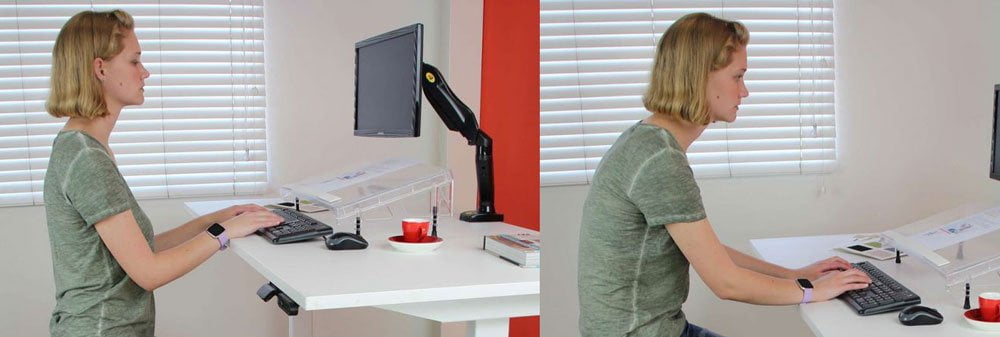
Seat height adjustment
Left: Seat height is too low and angle of the elbows is less than 900. Forearms are not parallel to the floor.
Right: Seat is too high and angle of the elbows is greater than 900. Again, forearms are not parallel to the floor. The hunched back typically results in muscular pain in the upper back and shoulders.
2. Adjust the depth of the seat (seat slider)
Office chairs equipped with a seat slider empower you to fine-tune the seat depth, enabling you to move the seat pan backward or forward to align with the length of your thighs. When you are seated comfortably with your back against the backrest of the chair, there should be a 2-3 finger gap between the front edge of the seat and the back of your knees. This practice not only prevents strain behind the knees but also provides optimal upper leg and under thigh support, promoting good blood circulation.
Note: Not all office chairs have a seat slider.
- For taller individuals with long legs, a seat slider allows them to INCREASE the seat depth, thereby maintaining a good sitting position. Conversely, shorter people should consider REDUCING the seat depth.
- If the seat is excessively long (deep), anyone with shorter legs might find themselves sitting on the front edge of the seat, leading to a lack of adequate back support.
The seat should also have a slight downwards curve in the front (waterfall front), to reduce the pressure on the back of your thighs. The importance of a good sitting posture.
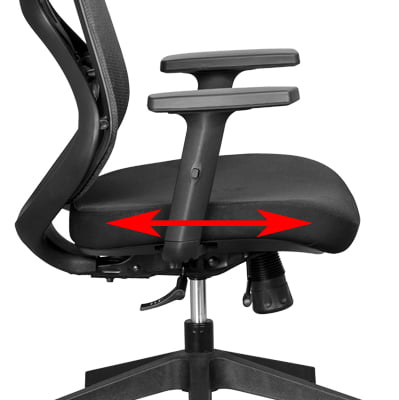
A good sitting position is when your back is properly supported by the backrest and there is a 2-3 finger gap between the front edge of the seat and the back of your knees.
Click here to see which chairs have a seat slider that allows seat depth adjustment.

3. Armrest adjustment for a good sitting position
When seated on the chair, your forearms should be parallel to the floor and your elbows should be bent at about 900. Incorrect armrest positioning can lead to muscle tension in your neck, shoulders, arms, and wrists.
- Armrests that are too high or low can cause muscle tension in your neck, shoulders, arms and wrists.
- Arm pads that move forward and backwards will allow you to sit closer to your desk. Your desk surface can then be used to support your forearms, wrists and hands.
- Armrests that are width adjustable or where the arm pads can pivot inwards are an advantage. If the armrests are too far apart, they will not be directly under your elbows and forearms and will therefore not provide the proper support and comfort.
- Find out more - see Office Chair Armrests Explained

4. Backrest angle adjustment
A chair that allows you to recline the backrest angle between 900 and 1100 is ideal. Sit with your back fully against the backrest. What is the difference between office chair mechanisms?
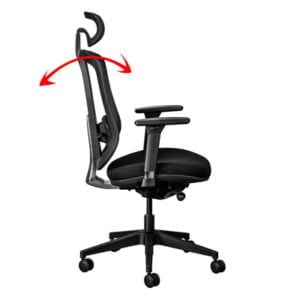
The ideal sitting position is when the chair backrest is unlocked (free-floating), so that it moves with your body. This will ensure that it provides continuous support. Furthermore, tiredness will be reduced as your core muscles will be stimulated and blood flow improved.
Make sure that you adjust the spring tension in the backrest to match your body weight.
Some chairs automatically adjust the spring tension in the mechanism to suit your body weight. Click here to see which chairs have an automatic self-adjusting tension mechanism.
5. Good lumbar support is important for a healthy sitting position
An important feature for every office chair is a height adjustable backrest and/or adjustable lumbar support.
Position the lumbar support so that it fits snugly into your lower back and keeps your spine in a neutral position.
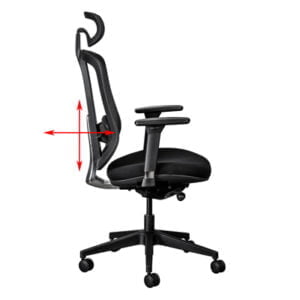
6. A headrest may improve your sitting position
Not all ergonomic chairs have a headrest and not every person needs one.
If your chair has a headrest, ensure it supports your neck and shoulders in their natural position. Improper headrest positioning can lead to tension headaches, upper back pain, and neck strain.
The headrest should be positioned so that it supports head in it’s natural position. In other words, the headrest must not push your head forward or allow it to fall backwards.
A headrest that is not suited to your height can cause more harm than good.
A headrest that is too low, may force you to hunch over and extend your neck forward. The forward angle of your head can result in tension headaches, upper back, shoulder, and neck pain.
For tall people, ensure that the headrest can be extended high enough to correctly support your neck and head. Best office chairs with a headrest for tall people.


An unhealthy sitting position – how NOT to sit

Taking breaks or doing a short workout increases energy, productivity and creativity, while also reducing stress and possible burnout.
Don’t:
- Lean to one side – it can cause your spine to curve.
- Hunch your shoulders – it may result in a forward head posture, neck strain, headaches and breathing difficulties.
- Lift your shoulders – it can cause muscular tension in your neck and shoulders.
- Sit forward without back support – the natural curve and alignment in your back won’t be supported.
- Cross your ankles or knees – it can lead to constricted blood flow, increased blood pressure and cause varicose veins.
- Let your feet dangle – it can cause constant pressure under your thighs and result in poor blood circulation and potential muscle pain.
- Keep your backrest in a fixed position – keep the backrest in a free-float position to continually stimulate muscles and blood circulation. This prevents lower back pain. If you have to keep your backrest in a fixed position for whatever reason, it is advisable to have your backrest in a slight recline.
- Sit for periods longer than 60 minutes without taking a break – sitting in a static position for a long time puts huge stress on your neck, spine and back muscles. When your body gets tired or you experience discomfort, get up and move around, have a tea break, go for a walk, or do some exercises. Simple exercises for office workers
If you don’t have an adjustable office chair, consider purchasing one. Why a fully adjustable office chair is important. A good ergonomic chair with adjustable features will allow you to create a healthy sitting position. This in turn will improve your wellbeing, comfort and productivity. However, this will only be the case if your chair is being used correctly!
Conclusion
Maintaining a good sitting position is crucial for your overall wellbeing, and having an ergonomic office chair is only beneficial if it's adjusted correctly. Follow our step-by-step guide and download our checklist to ensure that your chair is set up in the right way, promoting a positive impact on your daily work routine. Your comfort and productivity depend on it!
By the same author:
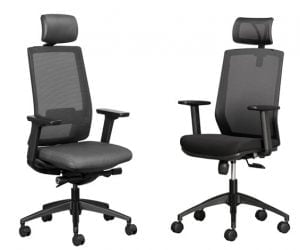
Why a fully adjustable office chair is important
We are all different, so when you buy a new office chair, look for one that has all the adjustability features.

What are the health benefits of a document holder?
One of the best ergonomic accessories you can get is a document holder.

Unveiling the True Cost of Ergonomic Office Chairs: Are they Worth the Investment?
Although the upfront cost of ergonomic office chairs may seem high, over their lifespan they are a low-cost and smart investment.



